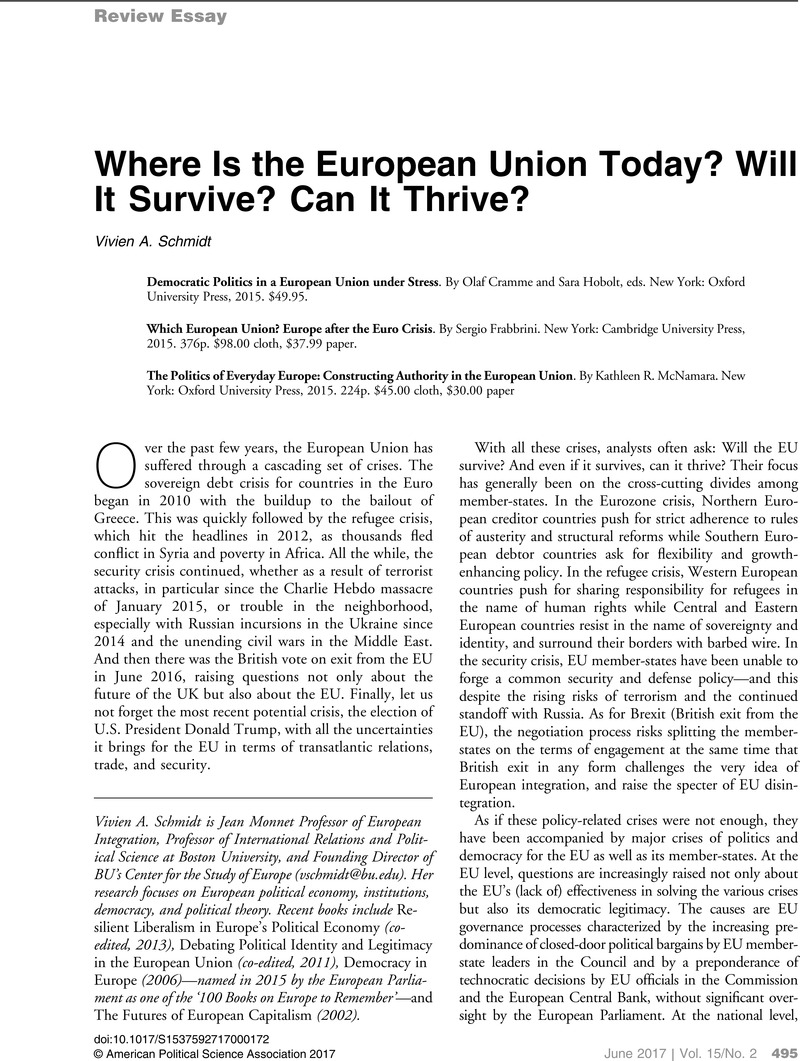No CrossRef data available.
Article contents
Where Is the European Union Today? Will It Survive? Can It Thrive?
Published online by Cambridge University Press: 08 June 2017
Abstract
An abstract is not available for this content so a preview has been provided. Please use the Get access link above for information on how to access this content.

- Type
- Review Essays
- Information
- Copyright
- Copyright © American Political Science Association 2017
References
Bauer, Michael and Becker, Stephan. 2014. “The Unexpected Winner of the Crisis: The European Commission’s Strengthened Role in Economic Governance.”
Journal of European Integration
36(3): 213–29.CrossRefGoogle Scholar
Bickerton, Christopher J., Hodson, Dermot, and Puetter, Uwe, eds. 2015. “The New Intergovernmentalism and the Study of European Integration.” In The New Intergovernmentalismm ed. Bickerton, Christopher J., Hodson, Dermot, and Puetter, Uwe. Oxford: Oxford University Press
CrossRefGoogle Scholar
De Rynck, Stefaan. 2016. “Banking on a Union: The Politics of Changing Eurozone Banking Supervision.”
Journal of European Public Policy
23(1): 119–35.CrossRefGoogle Scholar
Dehousse, Renaud. 2015. “The New Supranationalism.” Prepared for presentation at the Council for European Studies Annual Meetings, Paris, July 8–10.Google Scholar
Fabbrini, Sergio. 2016. “From Consensus to Domination: The Intergovernmental Union in a Crisis Situation.”
Journal of European Integration
38(5): 587–599.Google Scholar
Hall, Peter and Taylor, Rosemary. 1996. “Political Science and the Three New Institutionalisms.”
Political Studies
952–73.Google Scholar
Héritier, Adrienne
Moury, Catherine, Schoeller, Magnus G., Meissner, Katharina L., Mota, Isabel. 2016. “The European Parliament as a Driving Force of Constitutionalisation.” Report for the Constitutional Affairs Committee of the European Parliament. PE 536.467. Available at http://www.europarl.europa.eu/committees/en/supporting-analyses-search.html.Google Scholar
Hix, Simon and Høyland, Bjørn. 2013. “Empowerment of the European Parliament.”
Annual Review of Political Science. Palo Alto, CA: Annual Reviews, Inc.Google Scholar
Puetter, Uwe. 2014. The European Council and the Council: New Intergovernmentalism and Institutional Change.
Oxford: Oxford University Press.Google Scholar
Schmidt, Vivien A. 2008. “Discursive Institutionalism: The Explanatory Power of Ideas and Discourse.”
Annual Review of Political Science. Palo Alto, CA: Annual Reviews, Inc.Google Scholar
Schmidt, Vivien A. 2013. “Democracy and Legitimacy in the European Union Revisited: Input, Output and “Throughput.”
Political Studies
61(1): 2–22.Google Scholar
Schmidt, Vivien A. 2015. “Forgotten Democratic Legitimacy: ‘Governing by the Rules’ and ‘Ruling by the Numbers.’” In The Future of the Euro, ed. Matthijs, Matthias and Blyth, Mark. Oxford: Oxford University Press.Google Scholar
Schmidt, Vivien A. 2016a. “Reinterpreting the Rules ‘by Stealth’ in Times of Crisis: The European Central Bank and the European Commission.”
West European Politics
39(5): 1032–52CrossRefGoogle Scholar
Schmidt, Vivien A. 2016b. “The ‘New’ EU Governance: ‘New’ Intergovernmentalism versus ‘New’ Supranationalism plus ‘New’ Parliamentarism.” Cahiers du CEVIPOL Brussels Free University Working Papers 5/2016. Available at http://enlightenproject.eu/research-themes/legitimacy-of-european-modes-of-governance/.Google Scholar
Thelen, Kathleen. 1999. “Historical Institutionalism in Comparative Politics.” In The Annual Review of Political Science. Palo Alto. CA: Annual Reviews, Inc.Google Scholar




